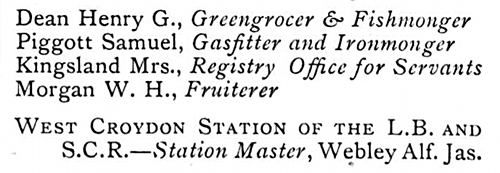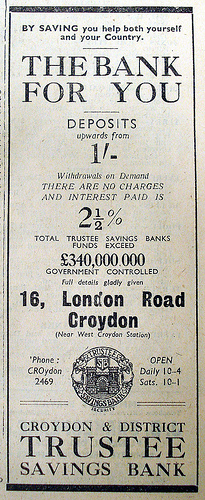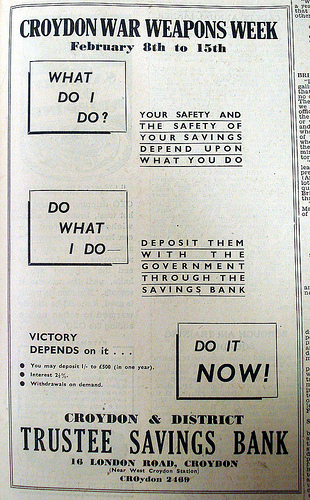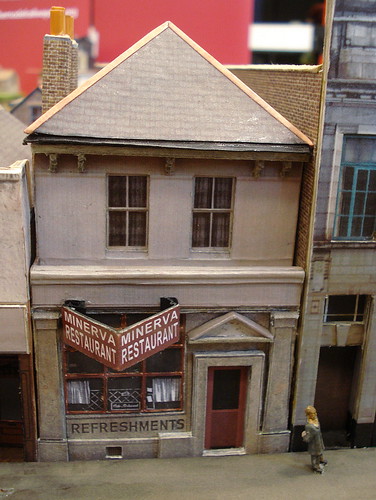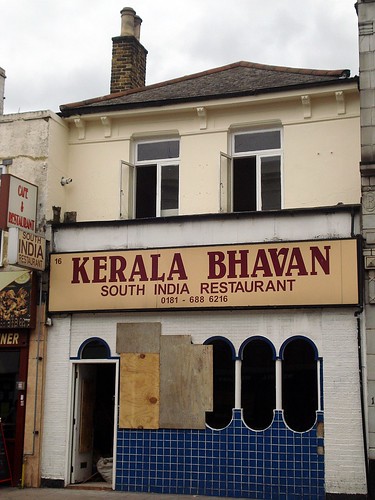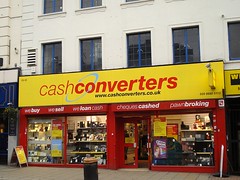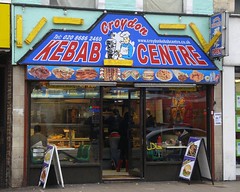The final member of the payday loan shop cluster around West Croydon Station is at number 16. The Money Shop opened in late 2011 on a site that, several decades earlier, was occupied by a rather different type of financial institution.
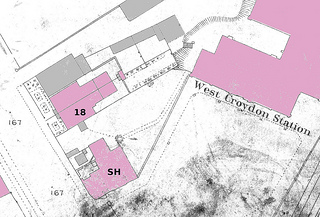
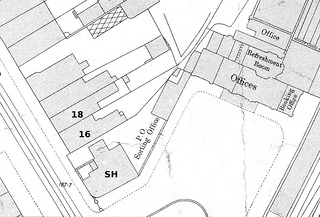
The building was constructed between 1868 and 1895, probably in 1875–6 or 1885–6. The 1868 Town Plans show a gap between Station House (later demolished and replaced by numbers 12–14) and the location of the present number 18, while in the 1894–5 Town Plans,[1] the gap has been filled in.
It’s not clear what the first use of the building was. It’s tempting to assert that this was the “Providence Villa” listed between West Croydon Station and Mrs Kingsland’s Registry Office for Servants in street directories from 1876 to 1885,[2] but as street numbers weren’t assigned to the east side of London Road until 1890, it’s hard to prove this directly. I’m quite sure that Mrs Kingsland’s office was at the current number 18,[3] and the 1868 and 1894–5 Town Plans make it clear that there was little space for anything aside from Station House and (potentially) Providence Villa between the station and Mrs Kingsland's office.
On the other hand, a plan included in the sales particulars for a building plot on Oakfield Road, auctioned by Podmore & Martin on 12 July 1877,[4] shows the site of modern number 16 to be vacant. The only date given on this plan is the date of the auction, so it could have been produced earlier. To reconcile this with the appearance of Providence Villa in Ward’s 1876, the plan would have to have been several months out of date by the time of the auction.[5] However, this isn’t out of the question. The relevant building plot was part of the old Oakfield Estate, which was auctioned off in pieces over a long period of time,[6] so it’s quite possible that the same base plan was used over and over again.
Another possibility is that “Providence Villa” was a fanciful renaming of Station House; as noted in my article on 12–14 London Road, Station House was used as the stationmaster’s house for some time. However, street directories note that the stationmaster in 1876 and for some time afterwards was Alfred James Webley, who seems unlikely to have been part of the family of Mrs Cross,[7] and who in any case is listed separately at the station itself.
According to a notice on page 4850 of the 20 October 1885 London Gazette, Mrs Cross died on 5 September 1885. The next edition of Ward’s directory, published in 1886, lists W H Morgan, fruiterer, between the station and Mrs Kingsland — no further mention is made of Providence Villa.
Mr Morgan was replaced by William Goodsell, fruiterer and greengrocer, around 1913, who in turn was replaced by Amalgamated Fruiterers Ltd around 1929. The run of fruit and vegetable purveyors ended just a couple of years later; by 1934, the property was occupied by “Carvers, Ham & Beef”.[8]
On 26 September 1935, the Croydon & District Trustee Savings Bank opened its first branch — and head office — at 16 London Road.[9] There were around a hundred other Trustee Savings Banks in the British Isles at the time, and the Croydon bank was one of three set up during 1935, the others being in Ilford and Cambridge.[10] The Croydon Times of 28 September 1935 reports that the bank was formally declared open by the Mayor of Croydon, Alderman J Trumble, who “said he was interested in the venture because it made for thrift, which, in turn made for prosperity.” The article emphasises that the bank would be “a local institution, managed by Trustees who were local people.”[11]
The Trustee Savings Banks were the predecessors of the TSB Group, which later merged with Lloyds Bank to form Lloyds TSB.[12] However, they were originally intended to provide an alternative to the commercial banks.
An article in the Coulsdon and Purley Times of 6 September 1935 provides a short history in connection with the upcoming opening of the Croydon branch: “The movement originated over 120 years ago when there were few, if any, thrift organisations which provided absolute security for the poorer sections of the community. The commercial banks of those days, the precursors of the modern joint stock banks, would not accept deposits of less than £10, which represented a very much larger sum in those days than it does now.”
The article further notes the contrast with the Trustee Savings Banks, which were run by unpaid, voluntary trustees: “Deposits may be made with sums of one shilling upwards, and as soon as one pound has been saved the account begins to bear interest at the rate of 2½ per cent. compound.”[13]
By the time the Croydon bank was set up, the Trustee Savings Banks had come under Government supervision, and they continued to emphasise financial responsibility. On 1 February 1936 the Croydon Times reported on a new method of paying the rates imposed by the Croydon Corporation (similar to our modern-day council tax). A “circular” would be distributed with each rate demand, describing the bank and stating that “the bank is prepared to open a deposit account with any ratepayer for the purpose of saving for rates... the sums so deposited, with accrued interest, to be paid to the Corporation against rate demands and electricity accounts sent by the ratepayer to the bank.” The bank’s annual report for 1937, quoted in the Croydon Times of 25 December that year, states that “The scheme of ‘Saving for rates,’ arranged by Croydon Corporation, continues to be used extensively.”[14]
Collective financial responsibility was considered as important as individual responsibility. Following the outbreak of the Second World War, the Trustee Savings Banks joined with the National Savings Committee and the Post Office Savings Bank in urging the populace to deposit their spare cash to assist the war movement. A statement on 21 November 1939 by the Chancellor of the Exchequer, announcing the War Finance Campaign, included the assurance that “any increase in the money deposited in these banks will serve the same National purpose as money invested in the new securities.”[15]
On 8 June 1940, the Croydon Advertiser and Croydon Times printed an appeal from the Mayor of Croydon for the people of Croydon to join in the upcoming National Savings Week of 9–15 June: “The object of National Savings Week is to bring home to everyone the vital need to turn danger into victory by providing the money to make the planes and tanks and guns without which no valour can prevail. [...] But save ‘until it hurts’ and lend to your Country in the sure and certain knowledge that you are rendering a very great service.” The Croydon Trustee Savings Bank was one of the institutions recommended by the Mayor as a repository for these savings.
The Croydon and District Trustee Savings Bank remained on London Road until April 1942, when it moved to Equitable House, 1 Wellesley Road.[16]
Much of the remaining history of 16 London Road was filled by a succession of cafés and restaurants. There’s evidence of a tea lounge called Barrycafs in the 1940s,[17] but by 1955 this had been replaced by the Minerva Restaurant.[18] The Minerva seems to have played quite an important role in the social lives of the people living on and around London Road — several of the people I’ve spoken to while researching this series of articles remembered it fondly.
Jenny Walker, who lived on London Road in the late 1950s and early 1960s, recalls: “We used to go there every Saturday, do the big shop [at Sainsbury's] in the morning and then go and have our, sort of small lunch, in the Minerva. [...] Lamb chops, and roast potatoes or something like that.”[19]
Shirley Locke, who lived in Broad Green between the mid-1950s and mid-1970s, has similar memories: “When I first met my husband, we used to go there Sunday nights and have our dinner. [...] Steak and chips, and things like that, or egg, and fish, you know, plain things.”[20]
The Minerva remained in place until at least 1974,[21] but then transformed into a rather different type of restaurant. A planning application from June 1977[22] proposed a new frontage sign: “Bangla Desh Curry Centre / Tandoori Restaurant / Take Away Service / Special English and Indian Food / Fully Licensed”. Several other Indian restaurants followed, with names including Agra (or possibly Aggra), Ramas, Gandhi Tandoori, Ahmed Tandoori, and South India Restaurant.[23]
The final Indian restaurant to find a home at 16 London Road was Kerala Bhavan. This name was first used around 1999, though given the presence of “South India Restaurant” as a subtitle on the frontage sign (as of 2011, at least), it’s possible that this was simply a renaming of the previous eponymous incarnation.[24]
As a fan of South Indian food, I was excited to see this so close to my house when I moved to West Croydon in July 2011. However, it was already in the process of becoming a payday loan shop at this point,[25] so I never got to visit Kerala Bhavan itself. The Money Shop opened just a few months later.
Thanks to: Jenny Walker; Shirley Locke; Brian Gittings; Karen Sampson at the Lloyds Banking Group Archives; John Clarke; Colin Withey; the staff at the Surrey History Centre; the Planning Technical Support Team at Croydon Council; all at the Croydon Local Studies Library; and my beta-readers Henry and Kerry.
Footnotes and references
- As with the 1868 (1870) Town Plans, you may see different dates given for these later plans. They were surveyed in 1894–5 and published in 1896. All Town Plans consulted at the Croydon Local Studies Library.
- Providence Villa is listed with occupant Mrs Cross in Ward’s 1876, Wilkins’ 1876–7, Worth’s 1878, Atwood’s 1878, Ward’s 1880, Ward’s 1882, Purnell’s 1882, and Ward’s 1885. Oddly, Ward’s 1884 lists Providence Villa as “unoccupied”.
- According to Ward’s street directories, Mrs Kingsland’s office was assigned the number 4 in 1890, and number 4 was renumbered to 18 in 1927.
- Viewed at the Croydon Local Studies Library, ref PM 265.
- One would generally expect the data for such a street directory to have been gathered by the end of the previous year, in order to allow publication early in the relevant year. The introduction to Ward’s 1876 directory confirms this, stating on page i that “the last Edition of this Directory” [i.e. the 1874 edition] was “published early in 1874”. However, delays did occur; for example, Ward’s 1880 directory states on page iv that “Some delay in the issue of this edition was caused by the General Election [...] The work has since been revised, and made as correct as possible to the date of issue.” I can find no statement of delay in the introduction to the 1876 edition, but a number of pages bear dates from the middle of 1876: for example, 10/7/76 on page i, 17/6/76 on page 49 (which is in the section where houses are listed consecutively by street, just a few pages before the London Road entries,) 21/6/76 on page 65, and so on. So it does seem likely that Ward’s 1876 directory was actually published in the middle of 1876 rather than at the beginning, and that the data was brought up to date before publication.
- I’ll cover the Oakfield Estate at greater length later in this series.
- The 1881 census lists Caroline Cross, widow, annuitant, aged 64, as head of a single-person household on London Road; and Alfred Webley, station master, aged 47, as head of a separate household including a wife, son, daughter, and lodger. Census consulted via Ancestry at the Croydon Local Studies Library.
- Information in this paragraph comes from Ward’s street directories. “Carvers, Ham & Beef” is the exact wording in Ward’s 1934 directory; I don’t know if “Carvers” is a surname or a description of what they did to the ham and beef.
- Information about the opening date of Croydon & District Trustee Savings Bank provided by Karen Sampson of the Lloyds Banking Group Archives, and confirmed via the 28 September 1935 Croydon Times article (which states that the opening was “on Thursday”, i.e. the 26th).
- An article in the Croydon Times of 15 February 1936 states: “There were 104 Trustee Savings Banks in the British Isles on November 20th, 1935, with 585 offices. The number of offices increased by 25 during the year, and of these three represented new Trustee Savings Banks established at Ilford, Cambridge, and Croydon, the remainder being new branches of existing Trustee Savings Banks.” Article viewed via microfilm copy of a newscuttings book (ref Z/324/2) at the Surrey History Centre.
- Article viewed on microfilm copy of newscuttings book at the Surrey History Centre.
- The merger with Lloyds took place in 1995. See History of the TSB Group on the Lloyds Banking Group website for more information.
- Article viewed on microfilm copy of newscuttings book at the Surrey History Centre.
- Croydon Times articles viewed on microfilm copy of newscuttings book at the Surrey History Centre.
- The chancellor’s statement is quoted in the Croydon Times of 13 January 1940, viewed on microfilm copy of newscuttings book at the Surrey History Centre.
- Information on move to Wellesley Road provided by Karen Sampson of the Lloyds Banking Group Archives. A notice in the Croydon Times confirms this, stating that “The Business of the Croydon and District Trustee Savings Bank will (from Tuesday, 7th April, 1942) be conducted at their New Address: Trustee Savings Bank, No. 1, Wellesley Road, Croydon”. Karen also notes that this bank moved from Wellesley Road to Katharine Street in 1955, and again to Park Street in 1963, before merging with another Lloyds TSB branch at the Whitgift Centre in 2007.
- Photo PH/96/2627 at the Local Studies Library shows “Barrycafs” on the frontage (pretty clearly a single word), with “Refreshments” lower down, below the window. A projecting sign reads “tea lounge”. The photo has “1940’s?” written on the back. A planning application dated 18 June 1948 (ref 48/319) describes a “proposed reconstruction of roof etc to kitchen for Barry Cafés [sic]”.
- Kent’s 1955 directory lists the occupant of 16 London Road as “Minerva Res. (prop D Vrionis)”.
- Audio-recorded conversation with the author, 25 February 2013. Jenny clarified later in the same conversation that the “big shop” was at Sainsbury’s, across the road from the Minerva.
- Audio-recorded conversation with the author, 20 March 2013.
- The Minerva is listed in Kent’s 1955 and 1956 directories; the 1967, 1971, and 1974–5 editions of the Croydon Classified Directory; and the August 1974 Goad plan.
- June 1977 planning application viewed on microfiche at Croydon Council offices (ref A77/103).
- Aggra [sic] is listed in Brian Gittings’ 1980 journal of Croydon shops; Ramas is listed in the March 1983 and March 1984 Goad plans and the 1984–85 London Shop Surveys; Ahmed Tandoori is listed in the April 1987 Goad plan; South India Restaurant is listed in the March 1990, June 1992, April 1994, and June 1995 Goad plans and the first edition (probably c.1998–1999) of Shop ‘Til You Drop. South India restaurant is also shown in a photo (ref PH/96/2405) at the Croydon Local Studies Library, with a sign in yellow text on a blue background; this photo has “Oct 1991” written on the back.
- Kerala Bhavan is listed in the September 1999, May 2002, and May 2011 Goad plans and the second edition (probably c.2002) of Shop ‘Til You Drop. It can also be seen in an April 1999 photo by Wanderer 30 on Flickr.
- The Money Shop’s planning application for a new shopfront (ref 11/01519/P) was granted on 21 July 2011.

